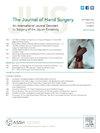运动轴突丧失患者腕管释放后自我报告的改善。
IF 2.1
2区 医学
Q2 ORTHOPEDICS
引用次数: 0
摘要
目的:电诊断研究可以识别腕管综合征(CTS)患者感觉和运动轴突丧失(AL)的证据。然而,感觉和运动AL对腕管释放(CTR)后预后的影响尚不清楚。我们假设,与有AL证据的患者相比,没有感觉和运动AL证据的患者在CTR后会有更大的改善。方法:四名接受过奖学金培训的骨科手外科医生接受开放和内窥镜CTR的患者。通过术前肌电图和神经传导检查确定感觉和运动AL。患者在手术前和术后3个月完成以下患者报告的结果:患者报告的结果测量信息系统上肢(UE)和疼痛干扰(PI)以及手臂,肩膀和手的残疾(QuickDASH [QD])。比较了有和没有感觉和运动al的患者的术前和术后评分、评分变化和达到最小临床重要差异(MCID)的比率。结果:纳入了175例患者。其中,91人表现为感觉AL, 98人表现为运动AL。有和没有感觉AL的患者的人口统计学匹配分析显示,术前、术后、UE、PI或QD的差异或符合MCID的比例没有差异。匹配分析显示,与非运动性AL患者相比,运动性AL患者术后UE(更好的功能)增加,术后PI(更少的PI)和QD(更少的残疾)降低,PI和QD的变化增加,QD符合MCID的比例更高。感觉性AL患者和非感觉性AL患者在ctr后的改善没有差异。然而,与我们的假设相反,运动性AL患者根据QD获得了更大的术后改善。这些发现表明,对于有AL证据的严重CTS患者,应推荐手术治疗。这些结果可以更好地为医生和患者讨论CTR结果的期望提供信息。研究类型/证据水平:预后II。本文章由计算机程序翻译,如有差异,请以英文原文为准。
Self-Reported Improvement After Carpal Tunnel Release in Patients With Motor Axonal Loss
Purpose
Electrodiagnostic studies can identify evidence of sensory and motor axonal loss (AL) in carpal tunnel syndrome (CTS) patients. However, the impact of sensory and motor AL on outcomes following carpal tunnel release (CTR) remains unclear. We hypothesize that patients with no evidence of sensory and motor AL will experience greater improvement following CTR compared to those with evidence of AL.
Methods
Patients undergoing open and endoscopic CTR by four fellowship-trained orthopedic hand surgeons were identified. Sensory and motor AL were identified using preoperative electromyography and nerve conduction studies. Patients completed the following before surgery and 3-month postoperative patient-reported outcomes: Patient-Reported Outcomes Measurement Information System Upper Extremity (UE) and Pain Interference (PI) as well as Disabilities of the Arm, Shoulder, and Hand (QuickDASH [QD]). Preoperative and postoperative scores, changes in scores, and rates of achieving the minimally clinically important difference (MCID) were compared between patients with and without sensory and motor AL.
Results
One hundred and seventy-five patients were included. Of these, 91 exhibited sensory AL and 98 exhibited motor AL. Demographic matched analysis of patients with and without sensory AL showed no differences in before surgery, after surgery, difference, or proportion meeting MCID for UE, PI, or QD. Matched analysis revealed no difference in preoperative PROMs between patients with and without motor AL. Patients with motor AL had increased postoperative UE (better function), decreased postoperative PI (less PI) and QD (less disability), increased changes in PI and QD, as well as a greater proportion meeting MCID for QD compared to those without motor AL.
Conclusions
There was no difference in post-CTR improvement between patients with and without sensory AL. However, contrary to our hypothesis, motor AL patients experienced greater postoperative improvement according to QD. These findings suggest surgery should be recommended for severe CTS patients with evidence of AL. These results can better inform physicians and patients as they discuss expectations of CTR outcomes.
Type of study/level of evidence
Prognosis II.
求助全文
通过发布文献求助,成功后即可免费获取论文全文。
去求助
来源期刊
CiteScore
3.20
自引率
10.50%
发文量
402
审稿时长
12 weeks
期刊介绍:
The Journal of Hand Surgery publishes original, peer-reviewed articles related to the pathophysiology, diagnosis, and treatment of diseases and conditions of the upper extremity; these include both clinical and basic science studies, along with case reports. Special features include Review Articles (including Current Concepts and The Hand Surgery Landscape), Reviews of Books and Media, and Letters to the Editor.

 求助内容:
求助内容: 应助结果提醒方式:
应助结果提醒方式:


